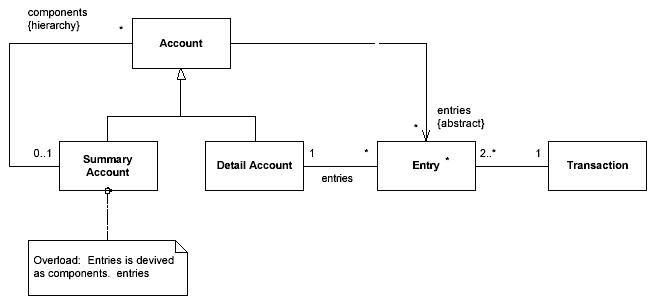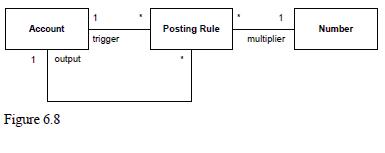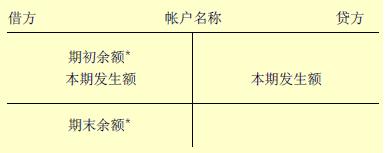Chapter6 Inventory and Accounting
My comments
(2009-2-3)
在讀這章時,對于這章開始的2頁概述一定要反復(fù)的讀。尤其是當讀到后續(xù)小節(jié),感覺迷失方向的時候,一定要回來再讀這部分,這部分是這章的一個高度的概括。
如果不具備會計的知識背景,花半天的時間惡補一下。建議看看《會計學(xué)原理(新編)》(徐文彬)。了解幾個關(guān)鍵的術(shù)語:賬戶,會計科目,復(fù)式記賬。
我先云山霧罩的讀了一遍,再回頭看這章的開始部分,對于Martin的闡述思路了解的清晰了,另外在惡補過基本的會計知識后,對Transaction和Summary Account理解起來老輕松了,真是磨刀不誤砍柴功J
Brief Summary
Account:賬戶
Entry:記賬分錄
Account can only be added or removed by entries. The entries provide a history of all changes of the account.
Account and Entry
Transactions
Transactions add a further degree of auditability by linking entries together. In a transaction, the items withdrawn from one account must be deposited in another. (我理解這句話的意思其實就是會計中所述的復(fù)式記賬Double entry,復(fù)式記賬一般就是指借貸記賬)
一般的Transsction就是財務(wù)上所說的“一借一貸”,而Multiegged Transsction就是財務(wù)上所說的“一借多貸”或者“一貸多借”。
導(dǎo)入以下的會計知識:
這是資產(chǎn)類帳戶的余額。如果是負債或所有者權(quán)益類帳戶,七期初余額、期末余額一般應(yīng)在貸方。
費用類帳戶和資產(chǎn)類帳戶一樣;收入和利潤帳戶和負債或所有者權(quán)益類帳戶。
“借”表示資產(chǎn)增加或負債以及所有者權(quán)益的減少;“貸”表示資產(chǎn)減少或負債以及所有者權(quán)益的增加.
“有借必有貸,借貸必相等”
Summary account:匯總賬戶
帳戶是根據(jù)會計科目開設(shè)的。會計科目既有總分類科目和明細科目,帳戶也就有總分類帳戶和明細帳戶。
‘原材料’是一個總分類帳戶,它只能概括但應(yīng)所有原材料的增減變化以其結(jié)果。在‘原材料’帳戶下面,還要按照每一種原材料分別設(shè)置明細分類帳戶。
‘應(yīng)收賬款’是一個總括反映應(yīng)收賬款結(jié)算情況的總分類帳戶,為了詳細反映應(yīng)收賬款的結(jié)算情況,還必須按每一個客戶設(shè)置應(yīng)收賬款明細分類帳戶。
Memo account:備注賬戶
備注賬戶并不需要保持平衡。
No real money leaks from or to a memo account.
Posting rules(簿記規(guī)則)
對于Posting rules,Martin要從以下的幾個方面來闡述:
1. Posting rules是什么
Posting rules allow us to build active networks of accounts that update each other and reflect business rules.
2. 如何實現(xiàn)簿記規(guī)則:Individual instance method
為什么要引入Individual instance method?這是因為簿記規(guī)則往往很復(fù)雜,不會僅僅是乘以一個系數(shù)這么簡單。例如計稅,不同的金額對應(yīng)不同的稅率。也就是說對于不同的實例(instance)會對應(yīng)不同的behavior。
3. Posting rules如何被執(zhí)行
Posting rule execution pattern describes ways in which posting rules can be triggered.
4. Posting rules在哪里定義
Posting rules for many accounts
Choosing entries
Accounting practice pattern: 這是為了給Posting rules進行分類
The source of an entry
Balance sheets and income statements(資產(chǎn)負債表和損益表)
Corresponding account
Specialized account model
Transactions
Account, entry和Transactions這三者之間的關(guān)系通過UML體現(xiàn)。這是這章的基礎(chǔ)。

entry和Transactions之間的關(guān)系就如同是先有雞還是先有蛋的問題。因為有約束條件,如果沒有創(chuàng)建Transactions就不能創(chuàng)建entry;同樣沒有entry也不能創(chuàng)建Transactions,這也是因為有約束條件。
解決方法就是Transactions負責創(chuàng)建entry,entry的創(chuàng)建操作僅能由Transactions來訪問。但是這樣或許會違背約束,No problem,我們可以定義規(guī)則就是:所有的public operations必須以所有約束條件都得到滿足為結(jié)束條件。
Transactions這個概念在實際的業(yè)務(wù)系統(tǒng)中是不存在的,它其實是人造的(artifical),是為了便于數(shù)據(jù)管理,畢竟我們現(xiàn)在用的還是關(guān)系型數(shù)據(jù)庫以及面向?qū)ο蟮脑O(shè)計方法哈。
Summary Account

注意這里Summary Account的記賬方式是和業(yè)務(wù)系統(tǒng)不同的。在實際的財務(wù)管理中,我們會在匯總賬戶和明細賬戶中分別編制會計分錄(Entry),而在業(yè)務(wù)系統(tǒng)中并不是這樣的,按照Martin的敘述:
1. The entries of a summary account are derived from the component’s entries in a recursive manner.
2. post entries only to detail accounts not to summary accounts.
Posting Rule
1. 什么是Posting Rules?(簿記規(guī)則)
Posting rule looks at a particular account and, when it sees an entry, creates another entry.

簡單的Posting Rule就是乘以一個因子,如圖Figure6.8.但是復(fù)雜的,例如計稅就要采用Figure6.9的模式。

注意這也就是為什么要引入Individual instance method的原因。(這個我也是看了2遍才明白的啊)
這句話很重要:We want the behavior to vary with each individual instance.
所以不能通過類繼承實現(xiàn)。Individual instance method就是討論如何實現(xiàn)“the behavior to vary with each individual instance”。
1. Individual instance method-如何實現(xiàn)簿記規(guī)則:
1) Singleton Class單一實例
2) Strategy Pattern
3) 使用內(nèi)部的case語句
在Posting Rule上我們要定義一系列的操作。
在Posting Rule上定義computeFor。ComputeFor包含case語句去調(diào)用上面的一系列的操作。
4) 使用帶參數(shù)的方法(Parameterized Method)
5) 解釋器Interpreter
最后Martin給出了選擇實現(xiàn)方法的原則。他的首選是:Parameterized Method。
不過我認為如果是做產(chǎn)品,解釋器Interpreter是不二的選擇。因為實際的業(yè)務(wù)系統(tǒng)的復(fù)雜程度絕不是任何人在產(chǎn)品開發(fā)過程中可以想象到的,最大的靈活性是追求的唯一目標。用開發(fā)的復(fù)雜性換取實施的靈活性。
2. Posting Rules在哪里執(zhí)行
原則:Separate the strategy of firing the posting rules from the rules themselves as much as possible to reduce the coupling between these mechanisms.
A. Eager Firing
當觸發(fā)賬戶中產(chǎn)生一個entry,posting rules就會被觸發(fā)執(zhí)行。
有2種方式:
A.在創(chuàng)建Transaction或entry的方法中posting rules被觸發(fā)。
B.使用Observer模式。Make Posting rules observer of their trigger account.這種方式比較復(fù)雜,盡量避免使用。
B. Account-based Firing基于賬戶的觸發(fā)
這是一種延時處理。對應(yīng)每個賬戶維護一個未處理交易條目列表,尤其適用于cyclic accounting system(循環(huán)記賬系統(tǒng))。每天account處理一次。
一定要注意賬戶的處理順序。
C. Posting-rule-based Firing
和Account-based Firing相似,只是Posting rule負責管理未處理交易條目列表。這種觸發(fā)方式比較復(fù)雜,盡量避免使用哈。
D. Backward-chained Firing
以當前操作帳戶(processing account)為輸出->找到posting rule->再推導(dǎo)出對應(yīng)的account(這就是要找出哪個帳戶觸發(fā)的當前操作帳戶)->對這些帳戶進行更新
E. 如何選擇posting rule的執(zhí)行方式:
要基于一下2點來考慮:
ü Posting rule執(zhí)行的時間
ü 希望在何處捕獲錯誤
Martin對這幾種方法的評價是:
Eager Firing沒有靈活性
Account-based Firing和Posting-rule-based Firing都具有很好的靈活性,帳戶結(jié)構(gòu)簡單使用前者,若復(fù)雜,則使用后者。
4. Posting Rules在哪里定義
兩種方法:
1) knowledge and operational level,posting rules定義在account type上。
2) 使用summary account,把posting rules定義在summary account,所有子帳戶也都遵循同樣的posting rules
對于這兩種不同方法的選擇的最主要的因素就是:the degree of difference in the behavior of the candidate accounts and account types.
Choosing the entry
有三種方法:
1) Getting all entries back and then doing a selection
2) Providing a selection-specific method
3) Using a filter。Filter就是一個封裝了查詢query的對象。Pattern見Figure6.24的時序圖。
posted on 2009-04-16 15:02 amenglai 閱讀(483) 評論(1) 編輯 收藏 所屬分類: PEAA分析模式 之 讀書筆記



